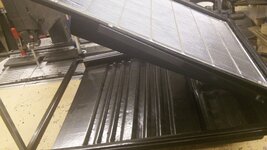UncleMatt
Bronze Member
- Jul 14, 2012
- 2,389
- 2,531
- Detector(s) used
- Garrett Infinium & Gold Bug II, Bazooka Super Prospector Sluice
- Primary Interest:
- All Treasure Hunting
- Thread starter
- #41
Here is another idea: a level bubble on your boomer box, with degree graduation marks on the boomer mounting tabs. This would allow you to use a level boomer box as a reference to set the angle of your sluice exactly. Assuming you have adjustable legs, you bring the top of your boomer box to level, and then look at where the top edge of the side of your sluice is indicating it sits relative to that level boomer box. This will show you if you are on your desired angle of operation, or if you need to make adjustments. Often this isn't needed, but if you discovered ideal operating parameters for your particular sluice, that would help you quickly dial it in after relocating to a new site.






